CTB Mapping Tutorial
What is this about?
This tutorial shows patterns that you can use in your own CTB specified beatmaps. This is a project where everyone who is interested in CtB mapping can participate. Only with your help the Thread will become more helpful to CtB mappers. In this tutorial we will focus on Basic and Advanced Patterns. Basic Patterns are necessary in pretty much every CTB specified difficulty while Advanced Patterns head beyond these basics and should be used after you gained some experience in CTB mapping.
You can download a beatmap with some of the Basic Patterns below here . I will add more to this later.
You can download a beatmap with some of the Basic Patterns below here . I will add more to this later.
A Guide about H-Spacing by Drafura
Introduction to CtB mapping using horizontal-spacing value (H-spacing):
As explained in the video CtB mapping is all about the X value of the objects, the H-spacing is the spacing value showed by the editor when two objects have the same Y value.
Where to find those values?

Bascially those values allows you to know if a jump is going to be easy, hard or hypered, that's why they're usefull in a first time. To know if a jump is going to be hypered you have to do some tests before and find at witch H-spacing the hyperdash is triggered. In my example, the h-spacing is triggered at around 2.50x h-spacing for a 1/2 beat. That basically means that if I use 2.45x h-spacing, the hyperdash will not trigger and the jump is going to be extremly hard. Depending on the difficulty of your map, you may want or not use this kind of jump.
Also, you have to be cautious about some things with those values:
Let's say you start a new map, finish the timing and take for example 2x slider speed. Before starting to map:
Another and last point you have to take care of about h-spacing is the difficulty of a jump after an hyperdash. Making "after hyper jumps" a slightly easier than your average jump is a good idea if you want to keep consistency cause those jumps are always harder due to the actual hyperdash mechanics.
As explained in the video CtB mapping is all about the X value of the objects, the H-spacing is the spacing value showed by the editor when two objects have the same Y value.
Where to find those values?
Bascially those values allows you to know if a jump is going to be easy, hard or hypered, that's why they're usefull in a first time. To know if a jump is going to be hypered you have to do some tests before and find at witch H-spacing the hyperdash is triggered. In my example, the h-spacing is triggered at around 2.50x h-spacing for a 1/2 beat. That basically means that if I use 2.45x h-spacing, the hyperdash will not trigger and the jump is going to be extremly hard. Depending on the difficulty of your map, you may want or not use this kind of jump.
Also, you have to be cautious about some things with those values:
- Always remember to compare objects using the same Y value. Keep in mind that the slider's end have their own Y but you can't see it in the editor, so make sure to align on the same approximative Y the objects you want to compare (a slider start/circle with the slider end).
- Each beatsnap divisor doesn't trigger the hyperdash at the same H-spacing. In my example using 2.5x h-spacing between two objects separated in the timeline by a 1/4 rythm will NOT trigger the hyperdash (It'll be 3x for this case). Please keep that in mind when mapping streams and long 1/1 jumps.
- Changing the slider velocity will change the h-spacing used to trigger an hyperdash.
Let's say you start a new map, finish the timing and take for example 2x slider speed. Before starting to map:
- Find the h-spacing where the hypers are going to trigger (In my example this is 2.5x with 1/2s).
- Then, do some other tests and try to find a good average jump for your difficulty (In my example, for an insane, let's say that we'll take 2x).
- Do this two steps for 1/1 and 1/4 (also 1/3 and 1/6 if you think you're going to use them a lot).
Another and last point you have to take care of about h-spacing is the difficulty of a jump after an hyperdash. Making "after hyper jumps" a slightly easier than your average jump is a good idea if you want to keep consistency cause those jumps are always harder due to the actual hyperdash mechanics.
What is a Basic Pattern?
A Basic Pattern should be used in every kind of CTB specified difficulty. They are very easy to create but it is very important that they suit the rhythm of the music. In standard converted maps we often have the problem that the Patterns look weird or not fitting in CTB. But if you decide to map a CTB specified mapset they need to make sense and feel logic for the player. This is what really makes a CTB difficulty more special. So let us start to introduce some patterns now. To check out these patterns by yourself you can download my CTB mapping tutorial.
Hidden Slider Paths


Usage: Often regular CTB modders told me not to use this pattern in my CTB specified difficulties but I really like this pattern on a long drown voice for example.
Usage: Often regular CTB modders told me not to use this pattern in my CTB specified difficulties but I really like this pattern on a long drown voice for example.
Inward Sliders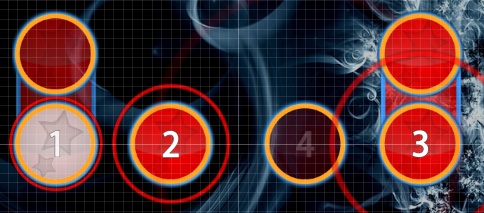


Usage:
I experimented a bit and tried to increase the distances between each Pattern. Also I tried to repeat exactly the same pattern a second time. This went pretty cool because we get two very surprising HDashes here which go both in the same direction. I'd recommend you to be careful with this anyway. If you add HDashes to this pattern it really has to suit the music perfectly.
Usage:
I experimented a bit and tried to increase the distances between each Pattern. Also I tried to repeat exactly the same pattern a second time. This went pretty cool because we get two very surprising HDashes here which go both in the same direction. I'd recommend you to be careful with this anyway. If you add HDashes to this pattern it really has to suit the music perfectly.
Jumpy Triples
Source: https://osu.ppy.sh/s/126059
Timing section: 00:13:923 (1,2,3,4,5,6) -
Difficulty: Platter
Explanation: Pretty much triple movements which create a little jump on the last note. If you are aware of symmetry here in harder difficulties this pattern can create a strong left to right or right to left dash-movement.[/b]
Source: https://osu.ppy.sh/s/126059
Timing section: 00:13:923 (1,2,3,4,5,6) -
Difficulty: Platter
Explanation: Pretty much triple movements which create a little jump on the last note. If you are aware of symmetry here in harder difficulties this pattern can create a strong left to right or right to left dash-movement.[/b]
Opposite Sliders
Options:
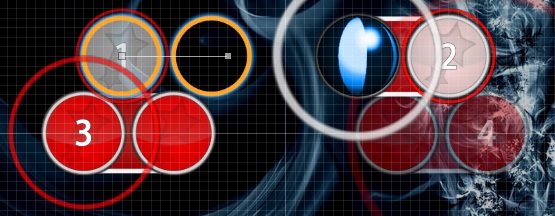
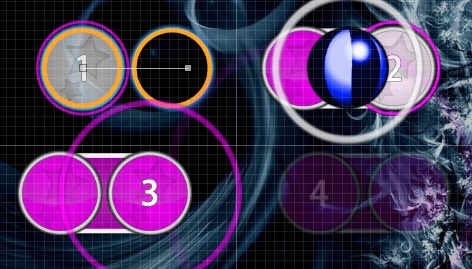

Usage:
This is a technical pattern that is mandatory to create dashy movements, especially when you increase the distance between each slider. Also the variety here is huge. You can use straight sliders which are placed parallel to the x Axis or even Y Axis (more challenging) or lopsided sliders (between x and y axis). Also different directions can de- or increase the challenge of this pattern. Think which kind of options you like here and if they fit with the music.
Usage:
This is a technical pattern that is mandatory to create dashy movements, especially when you increase the distance between each slider. Also the variety here is huge. You can use straight sliders which are placed parallel to the x Axis or even Y Axis (more challenging) or lopsided sliders (between x and y axis). Also different directions can de- or increase the challenge of this pattern. Think which kind of options you like here and if they fit with the music.
Overlapping sliders
Options:



Usage:
These sliders are a very often used technique in CtB mapping. In my chosen song they also fit quite well with the rhythm. Overlapping sliders create a lot of movement for the Ryuuta and there are thousand of options how to implement those in your map. In my tutorial I gave you three different examples. Check it out and see if you like it or not. I often use these when the rhythm itself repeats 4 times (1 stanza). 4 sliders are definitely more perceptible for the player than 2 sliders in this pattern.
Usage:
These sliders are a very often used technique in CtB mapping. In my chosen song they also fit quite well with the rhythm. Overlapping sliders create a lot of movement for the Ryuuta and there are thousand of options how to implement those in your map. In my tutorial I gave you three different examples. Check it out and see if you like it or not. I often use these when the rhythm itself repeats 4 times (1 stanza). 4 sliders are definitely more perceptible for the player than 2 sliders in this pattern.
Slider - Chains (reversed)
Options:
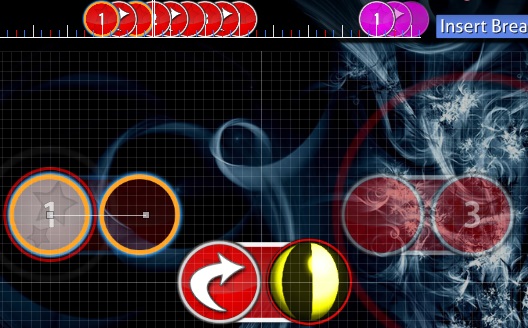

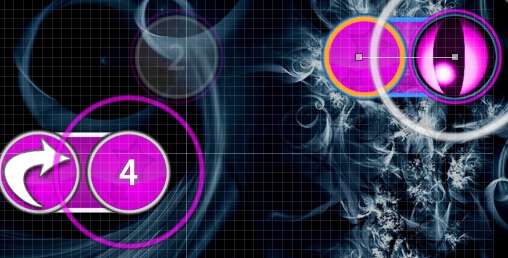
Usage:
This technique looks pretty simple. I personally love playing with sliders and reverse arrows when the song is made for it. Especially when there's a HDash before and you need to move after it pretty fast again cos it's a slider with reverse arrow that follows it. Sliders with reverse arrow in a row (chain) can be funny, in the tutorial song they aren't. If you listen closely the rhythm is not made for it. But I wanted to show you that pattern anyway.
Usage:
This technique looks pretty simple. I personally love playing with sliders and reverse arrows when the song is made for it. Especially when there's a HDash before and you need to move after it pretty fast again cos it's a slider with reverse arrow that follows it. Sliders with reverse arrow in a row (chain) can be funny, in the tutorial song they aren't. If you listen closely the rhythm is not made for it. But I wanted to show you that pattern anyway.
Streams
Options:

Usage:
I guess everybody here knows what a stream is. That happens usually on a very fast rhythm when a lot of notes appear already in a single stanza. Streams can always have the same distance between each note or you can increase the distance with each note to create more difficulty. Also you can vary between that, which means sometimes the distance gets lower, then bigger again. Be creative, do testplays on your map and see which kind of stream fits the best with your song.
Usage:
I guess everybody here knows what a stream is. That happens usually on a very fast rhythm when a lot of notes appear already in a single stanza. Streams can always have the same distance between each note or you can increase the distance with each note to create more difficulty. Also you can vary between that, which means sometimes the distance gets lower, then bigger again. Be creative, do testplays on your map and see which kind of stream fits the best with your song.
VVV Sliders
Options:
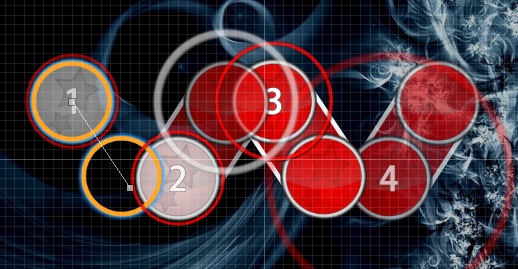


Usage:
This can be used on very fast sounds. The faster this pattern is the better. To make this harder you can also increase the distance between each slider. When the sliders are close together it works pretty much like a stream. But if you increase the distance the result will be Dashes and HDashes. Here it really depends. I'd never create HDashes if the distance between sliders has a 1/4 distance. At least not in difficulties which are below a Rain.
Usage:
This can be used on very fast sounds. The faster this pattern is the better. To make this harder you can also increase the distance between each slider. When the sliders are close together it works pretty much like a stream. But if you increase the distance the result will be Dashes and HDashes. Here it really depends. I'd never create HDashes if the distance between sliders has a 1/4 distance. At least not in difficulties which are below a Rain.
What is an Advanced Pattern?
Advanced Patterns do not appear in the CTB mapping beatmap I mentioned above. Here I only want to show you some that sometimes appear in CTB specified but also standard mapsets. Before you can map them you need to know about the Basic Patterns, so that you can modify them and make them more challenging. Advanced patterns are mostly hard patterns and should be used with caution. Try to avoid them in easy CTB difficulties, such as a Cup or Salad! Let's take a look on some examples we found together!
Avanced Slider Chains
[centre]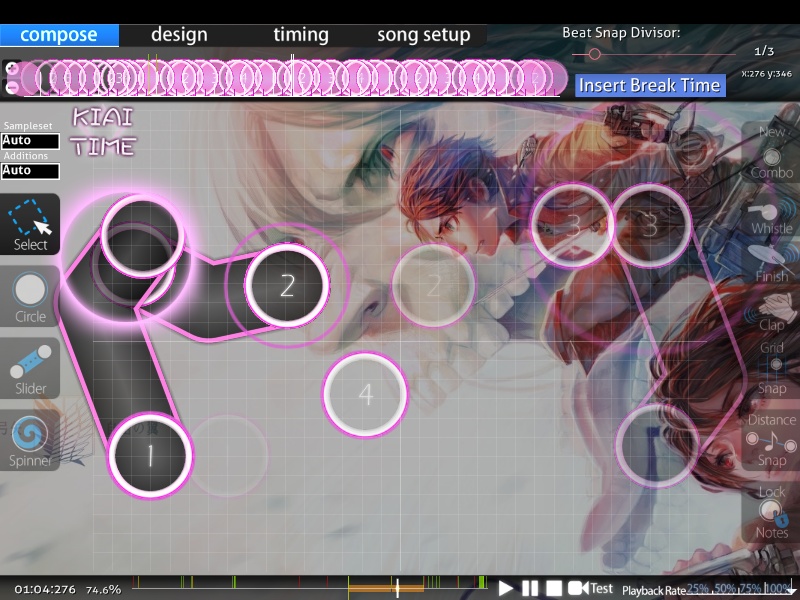
Source: https://osu.ppy.sh/s/118690
Timing section:01:02:755 (1,2,3,4,1,2,3,4,1,2,3,4,1,2,3,4,1,2,3,4,1,2,3,4) -
Difficulty: Overdose
Explanation: Please use that pattern with caution. It's very difficult and I would only use it in an Overdose. Probably one of the hardest Patterns we have here so far.[/centre]
Source: https://osu.ppy.sh/s/118690
Timing section:01:02:755 (1,2,3,4,1,2,3,4,1,2,3,4,1,2,3,4,1,2,3,4,1,2,3,4) -
Difficulty: Overdose
Explanation: Please use that pattern with caution. It's very difficult and I would only use it in an Overdose. Probably one of the hardest Patterns we have here so far.[/centre]
Bullet Rain
Source: https://osu.ppy.sh/s/104516
Timing section: 00:45:559 (1,2,3,4,5,6) -
Difficulty: Fruitender
Explanation: Bullet Rain explains this Pattern pretty well. 1/4 sliders appear here one behind the other rapidly. The distance between them is high enough to create a surprising HDash effect here. This only works well when the Beat is fast enough, also consider using these only in high difficulties.
Source: https://osu.ppy.sh/s/104516
Timing section: 00:45:559 (1,2,3,4,5,6) -
Difficulty: Fruitender
Explanation: Bullet Rain explains this Pattern pretty well. 1/4 sliders appear here one behind the other rapidly. The distance between them is high enough to create a surprising HDash effect here. This only works well when the Beat is fast enough, also consider using these only in high difficulties.
Dashy triplets
Source: https://osu.ppy.sh/s/133999
Timing section:00:07:360 (1,2,3,4,5,6,1) -
Difficulty: Rain
Explanation: Triplets are great, but they are even greater if they are connected with HDashes between. mingmichael showed very well how this is working.At 01:27:144 (1,2,1,2) - you also see how this pattern works without HDashes.
Also triplets can be mirrored, this makes the section even more jumpier and unexpected for the player. In editor mode it could look like this:

Source: https://osu.ppy.sh/s/133999
Timing section:00:07:360 (1,2,3,4,5,6,1) -
Difficulty: Rain
Explanation: Triplets are great, but they are even greater if they are connected with HDashes between. mingmichael showed very well how this is working.At 01:27:144 (1,2,1,2) - you also see how this pattern works without HDashes.
Also triplets can be mirrored, this makes the section even more jumpier and unexpected for the player. In editor mode it could look like this:
Full plate Walk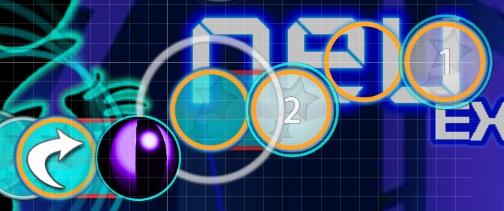
Source: https://osu.ppy.sh/s/28121
Timing section:02:08:494 (1,2,3) -
Difficulty: EX
Explanation: The idea here is horizontal sliders where the slider end and beginning don't lay above each other with 2 repeats following by other sliders with repears or 2 sliders above each other (Thanks bomber, lol). That's a very difficult pattern, so please use it with a lot of caution!!
Source: https://osu.ppy.sh/s/28121
Timing section:02:08:494 (1,2,3) -
Difficulty: EX
Explanation: The idea here is horizontal sliders where the slider end and beginning don't lay above each other with 2 repeats following by other sliders with repears or 2 sliders above each other (Thanks bomber, lol). That's a very difficult pattern, so please use it with a lot of caution!!
HDashes at the end of a Stream
Source: https://osu.ppy.sh/s/148238
Timing section: 00:20:032 (1,2,3,4,5,6,7,1) -
Difficulty: DeluZe
Explanation: Ursa included 6 beats of 1/8 section to create a stream. Since this whole part is very jumpy his idea was to create a surprising jump afterwards. This is an interesting idea for a harder difficulty but be aware of using 1/8 sections in lower difficulties such as Platter and below. Also this clearly has to suit the song!
Source: https://osu.ppy.sh/s/148238
Timing section: 00:20:032 (1,2,3,4,5,6,7,1) -
Difficulty: DeluZe
Explanation: Ursa included 6 beats of 1/8 section to create a stream. Since this whole part is very jumpy his idea was to create a surprising jump afterwards. This is an interesting idea for a harder difficulty but be aware of using 1/8 sections in lower difficulties such as Platter and below. Also this clearly has to suit the song!
Minifying HDashes
Source: https://osu.ppy.sh/s/45671
Timing section: 01:41:663 (1,2,3,4,5,6,7,8,1)
Difficulty: Deif's CTB
Explanation: Why should we always increase HDashes from note to note if they also can be decreased? Yes, that's right. This is pretty fitting at an ending of a song, often a decreasing distance is more surprising than an increasing distance. Deif did this in one of his first CtB mapsets. Check it out here: 01:41:663 (1,2,3,4,5,6,7,8,1) -
Source: https://osu.ppy.sh/s/45671
Timing section: 01:41:663 (1,2,3,4,5,6,7,8,1)
Difficulty: Deif's CTB
Explanation: Why should we always increase HDashes from note to note if they also can be decreased? Yes, that's right. This is pretty fitting at an ending of a song, often a decreasing distance is more surprising than an increasing distance. Deif did this in one of his first CtB mapsets. Check it out here: 01:41:663 (1,2,3,4,5,6,7,8,1) -
Mirrored HDashes
Source: https://osu.ppy.sh/s/130826
Timing section: 01:23:988 (4,5,6,7,8,9) -
Difficulty: Rain
Explanation: I found this very interesting pattern in eldnl's map which I want to share with you. Unfortunately the map is graveyarded already but I really like this dashy movement his difficulty requires at the end of the song. Check his Rain at 01:23:988 (4,5,6,7,8,9) - and you'll see what I mean. I would maybe reduce the distance a bit but the section is challenging and very interesting to play.
Source: https://osu.ppy.sh/s/130826
Timing section: 01:23:988 (4,5,6,7,8,9) -
Difficulty: Rain
Explanation: I found this very interesting pattern in eldnl's map which I want to share with you. Unfortunately the map is graveyarded already but I really like this dashy movement his difficulty requires at the end of the song. Check his Rain at 01:23:988 (4,5,6,7,8,9) - and you'll see what I mean. I would maybe reduce the distance a bit but the section is challenging and very interesting to play.
Multiple Streams
Source: https://osu.ppy.sh/s/148238
Timing section: 00:38:669 (4,5,1,2,3,4,5,1) -
Difficulty: DeluZe
Explanation: This pattern is well known. It is basically a pattern that is used by many people already. Only use it in very fast songs that require streams of that kind. This can make a stream much more interesting as described in the list of Basic patterns.
Source: https://osu.ppy.sh/s/148238
Timing section: 00:38:669 (4,5,1,2,3,4,5,1) -
Difficulty: DeluZe
Explanation: This pattern is well known. It is basically a pattern that is used by many people already. Only use it in very fast songs that require streams of that kind. This can make a stream much more interesting as described in the list of Basic patterns.
Opposite Sliders with HDashes
Source: https://osu.ppy.sh/s/65855
Timing section: 00:32:723 (7,8,9,10,11) -
Difficulty: Drafura's overdose
Explanation: You can also connect opposite Sliders with HDashes between. I found a map where Drafura made this and it really fits great to the beat. Go and check it by yourself.
Source: https://osu.ppy.sh/s/65855
Timing section: 00:32:723 (7,8,9,10,11) -
Difficulty: Drafura's overdose
Explanation: You can also connect opposite Sliders with HDashes between. I found a map where Drafura made this and it really fits great to the beat. Go and check it by yourself.
Wall Jump
Source: https://osu.ppy.sh/s/148238
Timing section: 01:04:057 (4,5,6) -
Difficulty: DeluZe
Explanation: You see a long slider followed by two circles. When you play this section you'll see what makes it so special. There are 2 HDashes and the last leads directly into the wall (wall jump). That creates a kind of kick effect, especially cool to play after a Stream.
Source: https://osu.ppy.sh/s/148238
Timing section: 01:04:057 (4,5,6) -
Difficulty: DeluZe
Explanation: You see a long slider followed by two circles. When you play this section you'll see what makes it so special. There are 2 HDashes and the last leads directly into the wall (wall jump). That creates a kind of kick effect, especially cool to play after a Stream.
Wiggling Dash Step
Explanation: Kick sliders that jump a distance from another and step side to side. This can be used in harder difficutlies very well.
Explanation: Kick sliders that jump a distance from another and step side to side. This can be used in harder difficutlies very well.
What is this about?
The video collection shows recordings about how to map CTB difficulties in any criterias. I do this especially to inspire people to see how a decent way of CTB mapping can look like. Once more videos are uploaded you will also get timing and Hitsounding Tutorials!
Also I will announce new videos in this Thread!
Also I will announce new videos in this Thread!
Can I participate?
You can if you fulfil the requirements below. If you are interested to share your own way of CTB mapping we will discuss if we can publish the videos on this Thread.
Are there any requirements to be a participant of this?
Yes. Unfortunately I cannot let any random person appear on this project. I prepared a list of which Prerequisites you need to fulfil.
- You need a recording and conversion program. Examples here are Fraps for recording and Any Video Converter for conversion. If you have an account on YouTube or Twitch I will share your it on the OP and you can feel free to give more videos whenever you like!
- You need at least 1 ranked CTB Guest Difficulty or CTB mapset. This is because I want to be sure that we really show videos of experienced mappers, especially to make mapping easier for starters and other interested people.
CTB mapping streamVideo sponsored by ZHSteven
Thanks a lot for your support!
Click here for the Live Stream!
Thanks a lot for your support!
Click here for the Live Stream!
HitsoundingVideo spondered by Drafura
Thanks a lot for your support!
Thanks a lot for your support!


